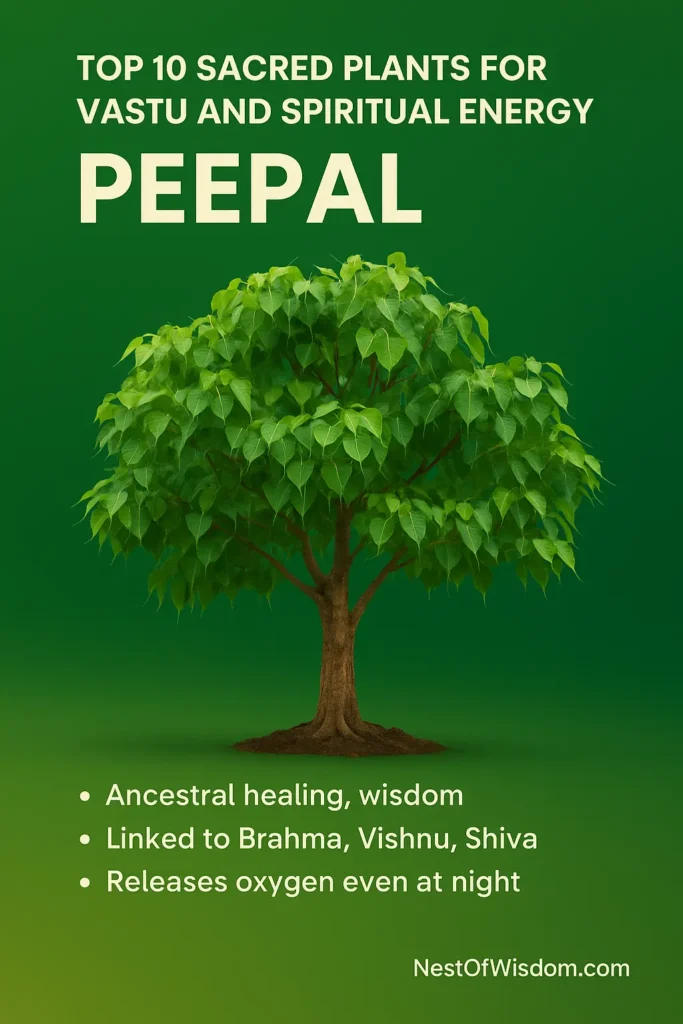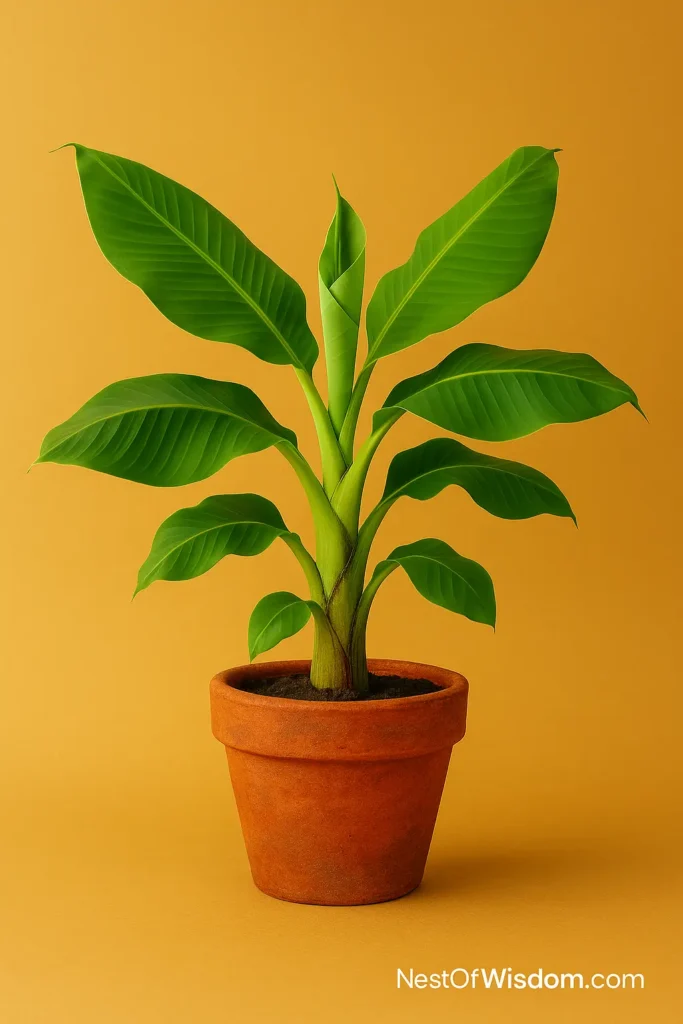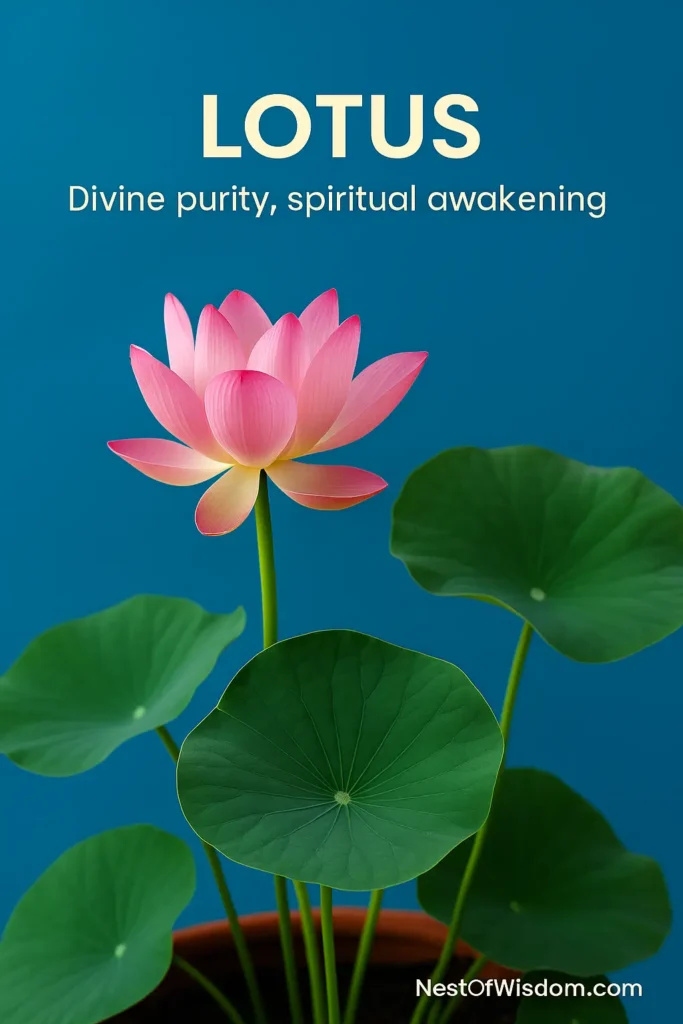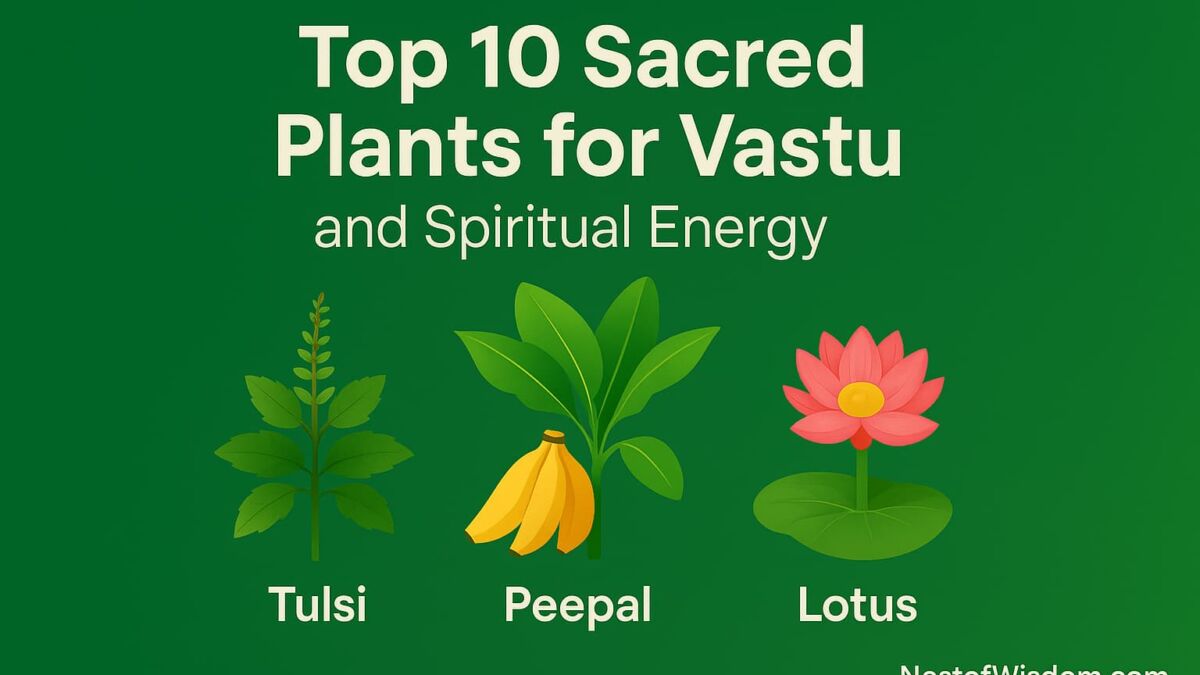🌿 Introduction
Sacred plants for Vastu are living conduits of sattvic energy. They don’t just decorate a corner—they purify, calm, and realign the home to a devotional rhythm. When you place sacred plants for Vastu with intention—light, cleanliness, and gentle daily rituals—ordinary balconies become sanctuaries.
“தாவரங்கள் தெய்வ சக்தியின் மென்மையான மொழி—அன்போடு வளர்த்தால் வீடு தெய்வீகமாகிறது.” (Plants speak the soft language of the divine—care turns a house into a sacred home.)
This guide walks you through the top 10 sacred plants for Vastu with Tamil names, precise placements, simple care, mini-rituals, and science-aware notes for modern apartments and family homes.
📑 Table of Contents
- Quick Table : Sacred Plants & Vastu Roles
- Why These 10 Sacred Plants for Vastu?
- Sacred Placement Basics (Vastu)
- The 10 Sacred Plants — Standardized Deep Dive
- Apartment & Balcony Sacred Corner (Layouts)
- Seasonal Care Calendar
- Common Mistakes & Easy Fixes
- Myths vs Facts
- 5-Minute Daily Mini-Ritual
- FAQs
- Internal Links
- External References
- Conclusion
🧬 Quick Table : Sacred Plants & Their Vastu Roles
| Plant | Core Role | Best Vastu Placement | Tamil Name |
|---|---|---|---|
| Tulsi | Purification, protection | North/East (pedestal/window) | துளசி |
| Neem | Aura cleanse, threshold guard | North/Northeast (entry/balcony) | வேற்ப்பிலை |
| Peepal | Ancestral wisdom | Outdoor West/South; symbolic indoors | அரசமரம் |
| Banana | Abundance, Lakshmi flow | Northeast (sun/wind-safe) | வாழை |
| Bilva | Shiva devotion | East/Southeast (near Shiva altar) | வில்வம் |
| Lotus | Purity & awakening | Puja room (water bowl/trough) | தாமரை |
| Banyan | Strength, longevity | Backyard/South (outdoor only) | ஆலமரம் |
| Ashoka | Emotional harmony | North/Northeast (calm corner) | அசோகவேளம் |
| Curry Leaf | Family nourishment | Bright kitchen/Northeast | கருவேப்பிலை |
| Sandalwood | Meditative peace | Puja/Northeast (fragrance) | சந்தனம் |
🌿 Why These Are the Top 10 Sacred Plants for Vastu
These time-tested choices are resilient, meaningful, and easy for families. Placing sacred plants for Vastu in light-filled, clean areas and pairing them with gentle mantras gradually transforms the mood of a home. “துளசி–வேம்பு இருக்கும் வீடு புண்ணிய அலை வீசும் வீடு.” (A home with Tulsi and Neem breathes a steady sacred current.)
🧭 Sacred Placement Basics (Vastu)
- Northeast (Ishan): Devotional flow—Tulsi, Banana, Neem, Ashoka.
- East: Sunrise prana—Bilva, symbolic Peepal, Lotus (puja).
- South: Stability—Banyan (outdoor), Curry Leaf.
- Puja room: Sandalwood & Lotus for meditation; keep clutter-free.
- Avoid: Toilets/SW corners for sacred greens; keep pots elevated and clean.
Water mindfully, wipe leaves weekly, and keep trays free from stagnation. Sacred plants for Vastu thrive on regular rhythm more than grand gestures.
🌱 The 10 Sacred Plants — Standardized Deep Dive


🌿 Tulsi (Ocimum sanctum) — துளசி
- Placement: East/North, bright but gentle sun; pedestal near entry/puja window.
- Care: Water when top 2–3 cm are dry; pinch flower spikes; monthly compost tea.
- Ritual: Light a lamp; offer water; chant 11× “Om Namah Shivaya”.
- Science note: Lifestyle use supported by reviews for antimicrobial/adaptogenic potential.
- Note: Great anchor among sacred plants for Vastu for daily devotion.
- Tip: Rotate the pot weekly; avoid over-fertilizing.
- Tamil: “துளசி தீபம்—மனம் மெதுவாக அமைதிப்படும்.”


🌳 Neem (Azadirachta indica) — வேற்ப்பிலை
- Placement: North/Northeast near thresholds or sunny balconies.
- Care: Deep but infrequent watering; fast-drain mix; light pruning; neem-cake mulch.
- Ritual: Hang a small leaf cluster at entry on festival days; gentle dhuni on auspicious evenings.
- Science note: Reviews discuss antimicrobial potential and wide traditional utility.
- Note: A protective “aura cleaner” in a set of sacred plants for Vastu.
- Tip: Diluted neem oil supports pest management across the balcony garden.
- Tamil: “வேம்பின் நிழல்—வீட்டின் கவசம்.”


🌳 Peepal (Ficus religiosa) — அரசமரம்
- Placement: Outdoor West/South in open ground; for apartments use symbolic leaf/idol facing East.
- Care: Full sun; not a long-term pot plant; allow ample rooting space.
- Ritual: Circumambulate on Saturdays; offer water at roots; sit quietly for 3 breaths.
- Science note: Folklore says “night oxygen”; CAM-linked genes exist but don’t give meaningful night supply at home.
- Note: Revered ancestor tree within sacred plants for Vastu.
- Tip: For flats, frame a dried leaf near the shrine to honor its energy symbolically.
- Tamil: “அரசின் அலை—ஆயுள் வேர்களை பலப்படுத்தும்.”


🍌 Banana (Musa spp.) — வாழை
- Placement: Northeast; protect from strong winds; allow sunlight.
- Care: Generous watering; rich compost; remove suckers to strengthen main stem.
- Ritual: Decorate doorposts with leaves during pujas; offer ripe fruit on Fridays (Lakshmi).
- Science note: Fast foliage boosts transpiration—refreshes balcony microclimate.
- Note: Abundance symbol among sacred plants for Vastu.
- Tip: Use a wide, heavy pot for stability; mulch thickly.
- Tamil: “வாழை—வாழ்வு வளத்தின் சின்னம்.”


🍃 Bilva/Bael (Aegle marmelos) — வில்வம்
- Placement: East/Southeast near a Shiva corner or picture.
- Care: Full sun; moderate water; excellent drainage; prune lightly after monsoon.
- Ritual: Offer trifoliate leaves on Mondays; chant “Om Namah Shivaya”.
- Science note: Reviews describe phytochemicals and traditional wellness uses.
- Note: Deeply devotional choice among sacred plants for Vastu.
- Tip: Train young branches to keep a graceful temple-friendly form.
- Tamil: “வில்வ இலை—சிவபூஜையின் இதயம்.”


🌸 Lotus (Nelumbo nucifera) — தாமரை
- Placement: Puja room; even a shallow bowl with clean water/petals supports meditation.
- Care: For live lotus, wide troughs in full sun; refresh water; avoid stagnation.
- Ritual: Place a petal at the altar; 3 slow breaths; focus on purity of intent.
- Science note: “Lotus effect” hydrophobic leaves stay clean—symbolic purity match.
- Note: Gentle reminder of detachment within sacred plants for Vastu.
- Tip: Tiny aeration stone keeps larger troughs fresh.
- Tamil: “அழுக்கற்ற அழகு—தாமரையின் தத்துவம்.”


🌳 Banyan (Ficus benghalensis) — ஆலமரம்
- Placement: Outdoor only—Backyard/South; never near foundations.
- Care: Full sun; space for aerial roots; deep watering during heat.
- Ritual: Offer water at dawn; sit under shade for grounding prayers (if space allows).
- Science note: Large canopy moderates heat and supports urban biodiversity.
- Note: Lineage pillar among sacred plants for Vastu.
- Tip: In apartments, use sacred art of Banyan to invoke strength symbolically.
- Tamil: “ஆல் நிழல்—ஆயுள் நெடிதாக.”


🌿 Ashoka (Saraca asoca) — அசோகவேளம்
- Placement: North/Northeast; a calm corner visible from the main room.
- Care: Bright to full sun; mulch; light pruning post-flowering.
- Ritual: Offer a flower at dusk; intention for harmony in speech and relationships.
- Science note: Soft foliage reduces harsh lines—perceived calming effect.
- Note: Heart-softening presence in sacred plants for Vastu.
- Tip: Pair with Tulsi to balance devotion and emotion.
- Tamil: “அசோக—துயரம் அகற்றும் மென்மை.”


🌿 Curry Leaf (Murraya koenigii) — கருவேப்பிலை
- Placement: Bright kitchen/Northeast; easy access for daily plucking.
- Care: 4–6 hours sun; avoid overwatering; compost + rock phosphate seasonally.
- Ritual: Offer a leaf at the stove before cooking; gratitude for nourishment.
- Science note: Aromatic leaves stimulate appetite and evoke “home”—uplifting family mood.
- Note: Practical sacredness—food is worship—within sacred plants for Vastu.
- Tip: Hard prune in spring to encourage lush, tender shoots.
- Tamil: “கருவேப்பிலை—சமையலின் புனித வாசனை.”


🕯️ Sandalwood (Santalum album) — சந்தனம்
- Placement: Puja/Northeast; fragrance supports japa and meditation.
- Care: Semi-parasitic; plant near a suitable host; warm sun and sharp drainage.
- Ritual: Apply a tiny tilak of paste; sit for 3 breaths, repeating your mantra.
- Science note: Aroma compounds (e.g., santalols) correlate with calm focus.
- Note: A peace anchor within sacred plants for Vastu.
- Tip: Keep weeds down around roots to reduce host competition.
- Tamil: “சந்தன வாசனை—மனதை மெல்ல அமைதியாக்கும்.”
🏡 Apartment & Balcony Sacred Corner (Layouts)
Use these compact layouts to arrange sacred plants for Vastu beautifully, even in small spaces:
- Devotion Anchor (Northeast): Center Tulsi on a pedestal; Neem toward the railing; Bilva bowl/leaves near a small Shiva photo.
- Prosperity Edge (Kitchen-side): Dwarf Banana + Curry Leaf; a brass bell or diya hook behind them.
- Meditation Nook: Low stool, water bowl with Lotus petal, Sandalwood paste for tilak; one tiny lamp niche.
📅 Seasonal Care Calendar
- Spring: Repot Tulsi/Curry; prune lightly; compost top-up; start Banana mulching.
- Summer: Deep watering in mornings; shade cloth if scorching; wipe leaves twice a week.
- Monsoon: Ensure drainage; tilt trays to avoid standing water; neem-oil spray for pests.
- Autumn: Gentle pruning; collect Bilva leaves for Monday pujas; clean pedestals and bells.
- Winter: Move tender pots slightly inward; morning sun priority; reduce watering frequency.
🚫 Common Mistakes & Easy Fixes
- Overwatering: Wait until topsoil dries; use finger test; mulch instead of “daily sips”.
- Dark corners: Sacred plants for Vastu still need light; shift 1–2 ft toward windows.
- Cluttered puja: Remove faded flowers daily; keep wicks fresh; wipe surfaces weekly.
- Wrong pot size: Up-pot gradually; ensure drainage; terracotta helps breathability.
- Expecting instant “energy fixes”: Think rhythm, not magic—water, wipe, chant, repeat.
🧪 Myths vs Facts (Science-Aware)
- Myth: Peepal pumps lots of oxygen at night. Fact: Studies show some CAM-linked genes under stress, but not a meaningful “night oxygen device” at home; honor it symbolically.
- Myth: Any corner works if it’s “sacred”. Fact: Light, airflow, and cleanliness matter for all sacred plants for Vastu.
- Myth: More fertilizer = faster blessings. Fact: Overfeeding harms roots; devotion is daily consistency, not chemical speed.
🪔 5-Minute Daily Mini-Ritual
- Light a lamp near Tulsi or your chosen anchor.
- Offer water and a fresh petal (Lotus or any bloom).
- Chant Om Namah Shivaya 11× with soft breath.
- Touch a leaf gently—say “நன்றி (thank you)”.
- Breathe out worry; breathe in peace. Let the home learn a softer breath.
❓ FAQs — Sacred Plants for Vastu
Q1. Which plant is most powerful for home Vastu?
For most families, Tulsi is the most practical daily anchor among sacred plants for Vastu.
Q2. Can I keep these in an apartment?
Yes—Tulsi, Curry Leaf, and dwarf Banana thrive in pots with good light. Use symbolic Peepal/Banyan art if space is tight.
Q3. Do sacred plants for Vastu fix bad energy instantly?
They uplift gradually. Pair right placement with cleanliness, sunlight, mantras, and consistent care.
Q4. Does Peepal release oxygen at night?
Not meaningfully in normal homes; treat it as a revered tree, not a device.
Q5. What’s a simple starter trio?
Tulsi + Curry Leaf + Banana—devotion, nourishment, and abundance for most homes.
🔗 Internal Links
- Best Indoor Plants for Health, Wealth & Positive Energy
- Grow Organic Vegetables at Home
- 7 Powerful Benefits of Chanting Om Namah Shivaya
- Monday Fasting (Somvar Vrat) — Shiva Devotion
- Tuesday Fasting (Mangalvar Vrat) — Hanuman Blessings
🌐 External References
- Tulsi — A Herb for All Reasons (Review, PMC)
- Neem — Antimicrobial Potential (Review, PMC)
- Aegle marmelos — Phytochemical & Biological Review (PMC)
- Ficus religiosa — Genome/Transcriptome Overview (PubMed)
✅ Conclusion & Gentle CTA
Sacred plants for Vastu bring more than greenery—they bring rhythm, gratitude, and a daily return to stillness. Start with one plant and one ritual. Let the home learn a new, softer breath.
Plant for beauty. Care for balance. Live with peace.
👉 Continue exploring: Best Indoor Plants for Positive Energy | Grow Organic Vegetables at Home
Nest of Wisdom Insights is a dedicated editorial team focused on sharing timeless wisdom, natural healing remedies, spiritual practices, and practical life strategies. Our mission is to empower readers with trustworthy, well-researched guidance rooted in both Tamil culture and modern science.
இயற்கை வாழ்வு மற்றும் ஆன்மிகம் சார்ந்த அறிவு அனைவருக்கும் பயனளிக்க வேண்டும் என்பதே எங்கள் நோக்கம்.
- Nest of Wisdom Insightshttps://nestofwisdom.com/author/nestofwisdom/
- Nest of Wisdom Insightshttps://nestofwisdom.com/author/nestofwisdom/
- Nest of Wisdom Insightshttps://nestofwisdom.com/author/nestofwisdom/
- Nest of Wisdom Insightshttps://nestofwisdom.com/author/nestofwisdom/
Related posts
Today's pick
Recent Posts
- Internal Linking Strategy for Blogs: A Practical, Human-Centered Playbook
- AI in the Automotive Industry: A Practical, Human-Centered Guide
- Cloud Tools for Small Businesses and Freelancers: The Complete Guide
- Generative AI in Business: Real-World Use Cases, Benefits & Risks
- 7 Life-Changing Daily Habits for Weight Loss Without Dieting


